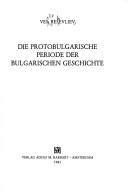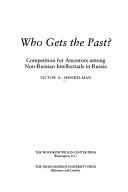| Listing 1 - 10 of 13 | << page >> |
Sort by
|
Book
ISBN: 9546171212 Year: 2011 Publisher: Bulgaria Издателска къща "Гутенберг"
Abstract | Keywords | Export | Availability | Bookmark
 Loading...
Loading...Choose an application
- Reference Manager
- EndNote
- RefWorks (Direct export to RefWorks)

ISBN: 9025608825 Year: 1981 Publisher: Amsterdam Hakkert
Abstract | Keywords | Export | Availability | Bookmark
 Loading...
Loading...Choose an application
- Reference Manager
- EndNote
- RefWorks (Direct export to RefWorks)
Bulgars (Turkic people) --- Bulgaria --- History
Book
ISBN: 9549198367 Year: 2011 Publisher: Bulgaria Фондация "Българско историческо наследство"
Abstract | Keywords | Export | Availability | Bookmark
 Loading...
Loading...Choose an application
- Reference Manager
- EndNote
- RefWorks (Direct export to RefWorks)
Bulgars (Turkic people) --- Nomads. --- Bulgaria --- History
Book
ISBN: 9549198324 Year: 2008 Publisher: Bulgaria Фондация "Българско историческо наследство"
Abstract | Keywords | Export | Availability | Bookmark
 Loading...
Loading...Choose an application
- Reference Manager
- EndNote
- RefWorks (Direct export to RefWorks)
Bulgars (Turkic people) --- Bulgaria --- Bulgaria --- History --- History
Book
ISBN: 9549198332 Year: 2008 Publisher: Bulgaria Фондация "Българско историческо наследство"
Abstract | Keywords | Export | Availability | Bookmark
 Loading...
Loading...Choose an application
- Reference Manager
- EndNote
- RefWorks (Direct export to RefWorks)
Bulgars (Turkic people) --- Bulgarian language --- Names, Bulgarian. --- Onomastics --- Etymology --- Names.
Book
ISBN: 9061433118 9789061433118 Year: 2006 Publisher: Amsterdam : Pegasus,
Abstract | Keywords | Export | Availability | Bookmark
 Loading...
Loading...Choose an application
- Reference Manager
- EndNote
- RefWorks (Direct export to RefWorks)
Bulgarians --- Ethnic identity. --- Bulgars (Turkic people) --- Slavs, Southern --- Ethnic identity --- Bulgaria --- Civilization. --- Ethnology
Book
ISBN: 5858402593 Year: 1992 Publisher: Kazan': Izdatel'stvo Kazan'
Abstract | Keywords | Export | Availability | Bookmark
 Loading...
Loading...Choose an application
- Reference Manager
- EndNote
- RefWorks (Direct export to RefWorks)
Bulgars (Turkic people) --- Ethnology --- Kazan Tatars --- Tatars --- Name --- Ethnic identity --- Tatarstan (Russia) --- History.

ISBN: 0801852218 Year: 1996 Publisher: Washington Woodrow Wilson center press
Abstract | Keywords | Export | Availability | Bookmark
 Loading...
Loading...Choose an application
- Reference Manager
- EndNote
- RefWorks (Direct export to RefWorks)
Bulgars (Turkic people) --- -Chuvash (Turkic people) --- -Ethnology --- -Tatars --- -Tartars --- Ethnology --- Mongols --- Turkic peoples --- Kereyid (Asian people) --- Cultural anthropology --- Ethnography --- Races of man --- Social anthropology --- Anthropology --- Human beings --- Chuvashes --- History --- Ethnic identity --- Chuvash (Turkic people) --- Tatars --- History. --- Ethnic identity. --- -History --- Tartars
Book
ISBN: 1282951327 9786612951329 9047444523 9789047444527 9781282951327 9789004180017 900418001X Year: 2010 Publisher: Leiden ; Boston : Brill,
Abstract | Keywords | Export | Availability | Bookmark
 Loading...
Loading...Choose an application
- Reference Manager
- EndNote
- RefWorks (Direct export to RefWorks)
This book is about Steppe Eurasia and China, Persia, Byzantium, as well as the 'Inside' and 'Outside' Other. This dual approach helps the reader to better understand the attitudes of the Steppe to both the southern sedentary empires (in this book, the 'Outside' Other) and to the women and shamans/magicians within the nomadic confederations (in this book, the 'Inside' Other), in the so-called 'Golden Age' of the Steppe Empire, e.g. between the sixth and ninth/tenth centuries.The result is a new and vivid picture of the Steppe's attitudes to 'otherness' and 'usness'. The book covers not only a long period of time, but also a vast territory, from Mongolia to the Black Sea and South-Eastern Europe. It studies many peoples and societies and their images of the 'Other', interpreted through different approaches and methodologies.
Steppes --- Bulgars (Turkic people) --- Other (Philosophy) --- Bolgars (Turkic people) --- Proto-Bulgarians --- Bulgarians --- Ethnology --- Finno-Ugrians --- Turkic peoples --- Grasslands --- Alterity (Philosophy) --- Otherness (Philosophy) --- Philosophy --- History --- Social aspects --- Social conditions. --- Bulgaria --- Civilization. --- Ethnic relations.
Book
ISBN: 1641899565 1942401531 9781942401537 9781641899567 9781942401520 1942401523 Year: 2018 Publisher: Leeds : ARC Humanities Press,
Abstract | Keywords | Export | Availability | Bookmark
 Loading...
Loading...Choose an application
- Reference Manager
- EndNote
- RefWorks (Direct export to RefWorks)
This book presents a reconstruction of the socio-economic, ethnic, cultural, and political history of the Carpathian-Danubian area in the eighth and ninth centuries at a period when nomadic peoples from the east including the Bulgars, Avars, and Khazars migrated here. The work is based on a comprehensive analysis of narrative and archaeological sources including sites, artefacts, and goods in the basin bordered by the Tisza river in the west, the Danube in the south, and the Dniestr river in the east, covering swathes of modern-day Romania, Moldova, Ukraine, Serbia, and Hungary.
Archaeology. --- Avars. --- Bulgars. --- Carpathian Mountains. --- Danube. --- Early Middle Ages. --- Khazars. --- Material Culture. --- Nomads. --- HISTORY / Medieval. --- Balkan Peninsula --- Europe, Eastern --- Carpathian Mountains --- Carpates --- Carpathians --- Carpații --- Karpaty --- East Europe --- Eastern Europe --- Balkan States --- Balkans --- Europe, Southeastern --- Southeastern Europe --- History --- Civilization
| Listing 1 - 10 of 13 | << page >> |
Sort by
|

 Search
Search Feedback
Feedback About UniCat
About UniCat  Help
Help News
News